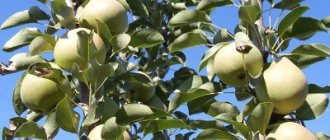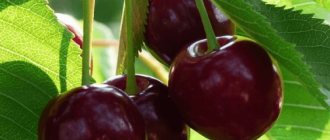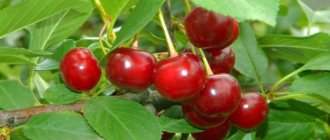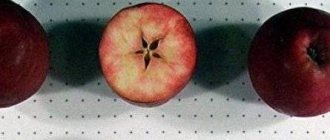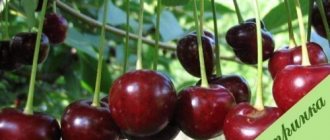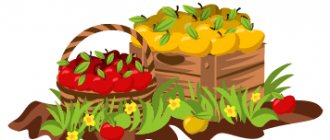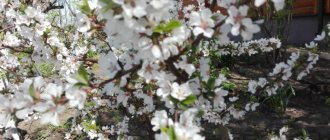Cherry variety Zhivitsa belongs to the duki group. Duke is a hybrid of cherry and black cherry, but is considered an independent cherry variety. Zhivitsa can be called a Western variety, since its parents are ancient European varieties: the German cherry Yellow Denisena and the early ripening Spanish cherry Griot Ostheimsky. The variety was created in Belarus relatively recently. Recommended for use at the place of creation in 2002. Then it began to spread in Ukraine and Russia. And in 2005 it was included in the Russian State Register of Breeding Achievements as recommended for use in the Central region.
- 2 Planting a cherry tree
2.1 Choosing a good place
- 2.2 Landing algorithm
The history of Duke Zhivitsa
The Zhivitsa variety (according to the originator - Zhyvitsa) appeared at the Belarusian Research Institute of Horticulture. Scientists E. P. Syubarova, P. M. Sulimova and M. I. Vyshinskaya crossed the following representatives of two cultures:
- Known since the end of the 18th century, the Griot Ostheim cherry (presumably originally from Spain), which became the parent form of many varieties. Its selection-significant characteristics are early fruiting, productivity and good taste.
- Denissena yellow cherries (in the sources there is a variant of Denissena yellow) with rather large yellow tasty fruits and a good level of frost resistance. The variety was bred in Germany in the first half of the 19th century.
Since 1990, Zhivitsa has been under state variety testing, and in 2002 it was approved for cultivation in the Central region. The variety was included in the State Register of the Republic of Belarus in 2005.
Video: practical tips for growing cherries
Cherry Zhivitsa is a new variety. The main experience of its cultivation has been accumulated in Belarus, and in Central Russia it has spread to few places and only recently, so there are still few reviews in sources about this variety. But judging by the descriptions - unpretentiousness, endurance and resistance to frost and disease, quick return of the first harvest - it has good prospects. Therefore, the one who lands it first can win. Moreover, it is planted for normal pollination along with other varieties that have already shown themselves to be good.
- Author: Gennady Chernikov
Rate this article:
- 5
- 4
- 3
- 2
- 1
(1 vote, average: 5 out of 5)
Share with your friends!
Description of Zhivitsa cherry
The plant has an almost straight trunk and a rounded crown, slightly elongated from bottom to top. The density of the branches is average, the foliage is high. The branches are raised and sagging. The color of the trunk is brownish-gray.
The leaves have an elongated shape. Their sizes are about 12 cm in length and 3-4 in width. Color – rich green. Most of the buds are formed on the shoots of the current year.
The flowers are small and white. The flowering period begins in mid-May. The variety is self-sterile, that is, fruiting without pollinators will be practically absent.
Top of the crown of the Zhivitsa cherry
The variety is classified as early ripening and winter-hardy. Recommended for cultivation throughout Belarus and Ukraine, as well as in central Russia. However, due to its good frost resistance, it adapts well to colder regions. There is numerous evidence of the successful cultivation of Zhivitsa cherries in the regions of the Urals and Western Siberia.
The hybrid has also adapted in the South. It is successfully grown in the North Caucasus and the Astrakhan region, although it has no commercial importance in these regions, since more productive heat-loving varieties can be grown in them.
Dimensions and height of Zhivitsa cherry
The diameter of the plant trunk rarely exceeds 10-12 cm. The rounded crown measures from 1.5 to 2.5 m. The height of the Zhivitsa cherry can range from 2.5 m to 3 m.
Description of fruits
Zhivitsa cherry berries are round in shape and medium in size. Their weight does not exceed 3.7-3.9 g. They have relatively fragile, delicate skin of a dark red color. The pulp of the hybrid is dense, but at the same time very juicy. It has the same color as the skin. The stone is small in size, freely separated from the pulp.
Ripe Zhivitsa cherry fruits
The taste is rated as very good, approaching excellent. There is a barely noticeable sourness in it. On a five-point scale, the taste of Zhivitsa cherry is rated at 4.8 points. The use of fruits is universal; they are consumed raw and processed. When preserved, they perform well, do not wander or explode.
Pollinators for Zhivitsa cherry
All cherry-cherry hybrids do not yet have self-fertile specimens. This is a serious problem for breeders, which they have been struggling with for decades. Cherry Zhivitsa was no exception. In addition, it does not have the possibility of cross-pollination with its own variety or related ones. For this purpose, all Dukes need only parent cultures.
The previously mentioned Griot and Denisenu can be used as a pollinator, but the use of closely related varieties is also acceptable. These include: Seedling No. 1, Novodvorskaya, Vyanok.
As a last resort, you can try to pollinate with an unrelated crop. Any variety that blooms around this time (1-2 decades of May) is suitable for this task. It is possible that it will be possible to find a previously unknown effective pollinator for the Zhivitsa cherry.
Attention! The greater the varietal diversity of cherries in the garden, the greater the likelihood of successful fruit set of the hybrid in question.
According to gardeners, the minimum required number of pollinating varieties for Zhivitsa cherry should be 3-4.
History of selection and region of breeding
The authors of this interspecific hybrid are E.P. Syubarova, PM Sulimova and M.I. Vyshinskaya from the Research Institute of Horticulture of Belarus.
Two ancient European varieties were taken as a parent pair: the early Spanish cherry Griot Ostheimsky and the German cherry Denisena Yellow .
From Griot Ostheimsky Zhivitsa borrowed early ripening and large fruit size , from Denisena she got frost resistance, sweetness and regularity of fruiting.
Zhivitsa has been in the state register of varieties since 2002 for the Central region of Belarus , and since 2005 for the entire country. Now this hybrid is successfully grown in Ukraine and central Russia.
Varieties such as Lyubskaya, Mayak and Morozovka are also grown successfully in these regions.
Description and characteristics of cherry Zhivitsa
The tree grows to medium size. It has a raised, rounded, medium-thick crown. Flower buds form on annual growths and bouquet branches.
The fruits are round, medium-sized, one-dimensional, weighing 3.7–3.8 grams. The skin is not very dense, tender, and has a dark red color. The pulp is of moderately dense consistency, juicy. The color of the pulp and juice is dark red. The taste is very good, sweet with a slight acidity, pleasant, tasters rated it 4.8 points. Sugar content - 8.73%, acids - 0.81%. The bone is small and free. The direction of use is universal.
Medium-sized dark red Zhivitsa cherry fruits
The fruits ripen early: the last ten days of June - the first ten days of July. The variety is quite early-bearing; trees on the seed rootstock begin to bear fruit in the fourth year after planting. The yield is high, 100 centners per hectare with a planting pattern of 3 x 5 m on a wild cherry seed rootstock. The productivity of one tree is about 15 kg. The ability to self-pollinate is absent.
Duke is winter-hardy. Plants have immunity to a complex of diseases, including coccomycosis and moniliosis, which are the most dangerous diseases of cherries.
Resin has many advantages:
- high productivity;
- very good taste of the fruit;
- versatility of use;
- good bone separation;
- early ripening;
- precociousness;
- winter hardiness;
- resistance to diseases.
The only disadvantage of the variety is self-sterility.
Harvest and storage
Cherry berries begin to ripen in mid-July - early August, and this is when the harvest should take place. For long-term storage, fruits should be removed from the branches along with the stalks and placed in soft, clean, dry containers, like wooden baskets or fabric-lined boxes.
The most comfortable conditions for preserving cherries are:
- dry, well-ventilated, clean room;
- air temperature 0…+5°С;
- relative humidity 80–90%.
Important! Fruits collected early in the morning have the greatest nutritional value. Also, such berries can last longer.
Under such conditions, cherries are able to retain their presentation and taste for two weeks.
Harvesting must be done carefully so as not to damage the fruits.
Harvesting must be done carefully so as not to damage the fruits.
Zhukovskaya cherry, thanks to its high technical characteristics, excellent fruit quality and ease of cultivation, has remained one of the most beloved varieties cultivated by domestic gardeners for many decades. The crop is able to please with consistently high yields, while requiring fairly standard care, which consists of timely watering, fertilizing and pruning.
Planting and care
The hybrid Zhivitsa takes root well both in autumn and spring planting. It is only important to observe the optimal timing of planting the seedling.
In both cases, it is better to plant a young plant a little earlier than to be late with planting.
Before planting, you need to trim off damaged branches and roots.
The planting hole is prepared in advance. Its depth should be 40-45 cm, diameter - half a meter or more. Fertile soil should be prepared to cover the roots.
Having covered the roots with soil, it is thoroughly compacted.
It is necessary to make a small roller along the edge of the planting hole to retain irrigation water.
The seedling is watered abundantly immediately after planting in several doses with water that has stood in the sun. Total water consumption is 2-3 buckets.
If after the last watering the soil settles, exposing the root collar, you need to add more soil. Then the root circle is mulched.
Important! Mineral fertilizers and manure should not be applied during planting, as they can damage young roots, which will worsen its survival rate.
They begin to fertilize cherries from 3-4 years of age, i.e., with the beginning of fruiting. Organic fertilizers (rotted manure, compost, sapropel) are applied once every 2-3 years.
Phosphorus and potassium salts should be added at the end of the growing season, and nitrogen salts at the beginning.
Soon after flowering, the plant is fed with a highly soluble complex fertilizer with microelements.
Watering should be regular, especially in dry summers. Cherries need water most during the fruiting period.
When watering, pay attention to ensure that moisture penetrates to a depth of at least 40-50 cm.
The Zhivitsa variety practically does not need pruning: the crown grows slowly, and thickening of the branches is usually not observed. It is necessary to trim only aged, excessively drooping branches and those that are largely bare.
The root growth of the Zhivitsa hybrid is almost not formed. This is both a positive and negative quality. On the one hand, it is easier to care for the garden, on the other hand, it is not possible to propagate the variety in this way.
For propagation, you can use seed sowing, but their germination rate is very low, and the seedlings do not always exactly correspond to the varietal characteristics.
Tip: To increase germination, seeds are sown immediately after collection.
Features of growing cherry hybrid Zhivitsa
The agricultural technology for growing dukes and their parent crops is largely similar. Cherry cherry has some cultivation peculiarities, but they do not create problems for the gardener.
Landing
In the zoning region, spring planting is preferred. If, however, the seedling was planted in the autumn, it should be completely covered for the winter with material that allows air to pass through. As already mentioned, in industrial gardens trees are planted according to a 3 x 5 m pattern; in an amateur plot, provided that the crown is trimmed in a timely manner, the row spacing can be reduced to four meters. Dukes are undemanding to soil fertility, and excess nutrients can be harmful to plants.
Overfed trees undergo an active, protracted growing season, as a result of which their wood does not have time to ripen by the beginning of winter, which negatively affects winter hardiness. Therefore, when planting, you should not get carried away with preparing soil mixtures excessively enriched with organic and mineral fertilizers.
On poor soils, you can add 8–10 kg of humus or compost, one and a half liters of wood ash and 200–300 grams of superphosphate into the planting hole. On fertile soils, organic matter is not added. When planting, you need to make sure that the root collar is not buried and is exactly at soil level. The remaining requirements for growing conditions and the planting process are standard for cherries.
Features of care
Caring for Zhivitsa cherries is standard. This includes infrequent watering, fertilizing in poor soils and regular pruning at the end of the season.
Watering and fertilizing schedule
Watering is done more often than once every 2-3 weeks, since the root system of adult trees is branched. If there is a sufficient level of precipitation, artificial irrigation may not be necessary at all.
Feeding is done twice per season:
- in early spring - nitrogen components (no more than 20 g per tree);
- at the end of autumn - superphosphate and potassium fertilizers (30 and 20 g per plant, respectively).
Trimming
It forms a crown on its own, so it does not need any specific pruning. However, it is believed that the further north the growing area, the shorter the height of the tree as a whole. In very cold regions (with winters when the temperature drops to -30 °C), it is recommended to form a trunk and crown in a bush-like form.
The crown is too thick, requiring regulatory pruning
Other types of pruning (sanitary, thinning and stimulating) have no special features; they are performed as needed.
Preparing for winter
The Zhivitsa cherry variety does not require any special procedures in preparation for wintering. It is recommended to carry out sanitary pruning at the end of October and whiten the trunks to protect them from rodents.
Selection of seedlings for planting
It is better to choose planting material in a nursery, where you can get reliable information about the age of the seedling and the type of rootstock.
Criterias of choice:
- age - 1–2 years;
- height - for one-year-olds - up to 80 cm, for two-year-olds - up to 110 cm;
- condition of the bark - integrity of the cover, absence of cracks, spots, even color;
- roots - the length of root shoots is from 20 to 25 cm, flexible, without damage;
- the trunk is strong and even.
Important! A seedling that exceeds the height required for its age was clearly grown with the abuse of nitrogen fertilizers. Such material does not have good resistance to diseases and cold. It is better to purchase grafted specimens: they enter the fruiting period earlier and bring more harvest.
It is better to purchase grafted specimens: they enter the fruiting period earlier and bring more harvest.
Diseases and pests
Cherry Zhivitsa has good disease resistance. However, it is recommended to carry out regular measures to counteract diseases such as coccomycosis and moniliosis.
Cherry coccomycosis
These measures include regularly digging up the soil at the beginning and end of the season, as well as destroying dry grass and leaves in late autumn. It is recommended to spray trees and soil in the tree trunk with copper-containing preparations;
- copper chloroxide 0.4%;
- Bordeaux mixture 3%;
- copper sulfate 4.5%.
These measures should be applied during kidney swelling.
Reviews about the variety
My cherries bloomed for the first time this year (I uprooted several old cherries of local unknown varieties), it seems that there should be an ovary.
I planted a variety of our local Belarusian selection - cherry - the cherry hybrid Zhivitsa. Self-sterile, but winter-hardy and resistant to diseases such as coccomycosis and moniliosis. For pollination, I planted cherry varieties Iput and the Belarusian variety Sopernitsa nearby. I hope now I will have a good harvest. https://forum.prihoz.ru/viewtopic.php?t=1148&start=1215
Leisem
Last weekend I took a special walk through my village; all the cherry blossoms were sheltered from the winds and grew either behind large trees or behind buildings.
Perhaps choosing the right place for cherries is one of the components of success in growing cherries; besides it, of course, critical winter temperatures, proximity to groundwater and soil acidity are also important. A cherry spot can be created manually. FatMax
https://forum.prihoz.ru/viewtopic.php?f=37&t=1148&sid=a086f1d6d0fd35b5a4604387e1efbe36&start=1230
New varieties that I have hopes for, first flowering.
Zhivitsa (duke) and Griot Belorussky. 5 flowers - 5 ovaries. So they are self-sterile... The resin bloomed very early. It bloomed when the cherries were already blooming... They grow far away, about 60 meters away, they bloomed when the cherries were just throwing out their buds. But perhaps Zhivitsa was able to pollinate from them, or they cross-pollinated with Griot. The top of Zhivitsa's growths is pink, unusual for cherries. Dim
https://forum.prihoz.ru/viewtopic.php?f=37&t=1148&start=1245
Harvest and storage
Fruiting of Volochaevka begins in the 4th year of life. An adult tree produces a harvest of up to 15 kg.
Cherry is not a crop whose fruits are picked prematurely, since the berries do not ripen, remaining sour. You can’t let it overripe, otherwise most of the fruits will fall off and rot. In the southern regions, the berries ripen in early July, in the central regions - in the middle of the month, and in northern climates - at the end of July.
The collection is carried out in dry weather, in the morning or evening, when the sun is not too active. For storage or transportation, cherries must be collected together with the stem or part thereof. For further processing, the fruits can be picked without the petiole. In this case, you need to take into account that the berries will only be stored for 2-3 days, and then they will begin to deteriorate.
Important! 2 weeks before the expected harvest, you should not water the trees, otherwise the fruits will be watery.
If the cherries are harvested during a rainy period, most likely the berries will be sour and their shelf life is much shorter. It is better to process such a harvest for winter harvesting.
For storage, fruits with petioles are placed in wooden boxes and placed in a dry room at a temperature of 0...-2°C and air humidity at 90%.
The Volochaevka cherry variety is worthy of the attention of farmers: it has excellent taste characteristics, high annual yields and many other advantages. Even a beginner in gardening can cope with growing crops.
Diseases and harmful insects
Diseases and harmful insects affect the Zhivitsa variety to a small extent, like most hybrids.
This cherry crop is not affected by either coccomycosis or moniliosis. It is from these diseases that cherries have been suffering lately.
There are also varieties that are immune to coccomycosis: “Tsarevna”, “Shalunya”, “Ashinskaya”, “Fairy”.
In very rare cases, aphids attack a tree. And birds do little harm to this variety compared to other cherry varieties.
The high marketability, excellent taste and ease of care of the Zhivitsa variety allow it to be widely used in private garden plots and on an industrial scale.
Due to its frost resistance, this hybrid crop can be grown further north.
Also undemanding varieties are: “Griot Moskovsky”, “Igrushka”, “Lyubskaya”
Advantages and disadvantages
Lyubskaya cherry is one of the best technical varieties, the main advantages of which are:
- high percentage of self-fertility;
- flowering occurs at the end of May, so flowers and ovaries are not damaged by spring frosts;
- By providing these fruit trees with appropriate care, you can achieve high yields from the variety;
- the sparse crown and miniature size make it easier to care for the branches and collect ripe fruits;
- even if the care is not very good, the fruiting of the Lyubskaya cherry is still quite high;
- easy to separate the seeds from the pulp;
- the harvested crop tolerates transportation well over long distances and is stored in a cool place for a long time;
- the fruits easily move away from the stalks, but do not fall off;
- ripe fruits are quite large.
This cherry has few disadvantages:
- poor resistance to fungal diseases;
- in regions with a harsh climate, this cherry does not grow without additional shelter;
- fruits are too sour;
- The trunks of this variety often suffer from sunburn.

